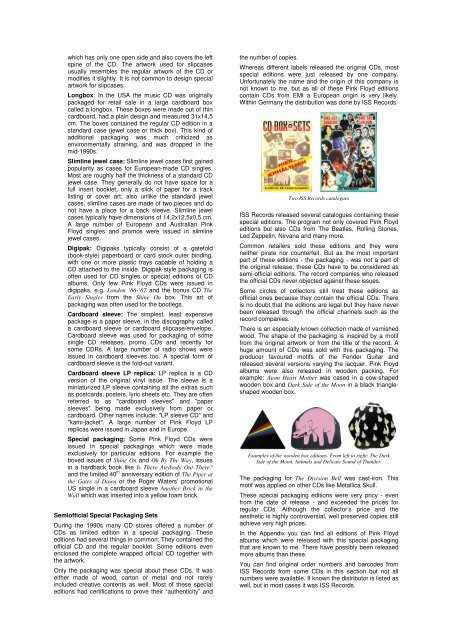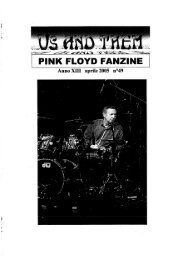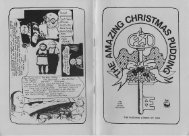You also want an ePaper? Increase the reach of your titles
YUMPU automatically turns print PDFs into web optimized ePapers that Google loves.
which has only one open side and also covers the left<br />
spine of the CD. The artwork used for slipcases<br />
usually resembles the regular artwork of the CD or<br />
modifies it slightly. It is not <strong>com</strong>mon to design special<br />
artwork for slipcases.<br />
Longbox: In the USA the music CD was originally<br />
packaged for retail sale in a large cardboard box<br />
called a longbox. These boxes were made out of thin<br />
cardboard, had a plain design and measured 31x14,5<br />
cm. The boxes contained the regular CD edition in a<br />
standard case (jewel case or thick box). This kind of<br />
additional packaging was much criticized as<br />
environmentally straining, and was dropped in the<br />
mid-1990s.<br />
Slimline jewel case: Slimline jewel cases first gained<br />
popularity as cases for European-made CD singles.<br />
Most are roughly half the thickness of a standard CD<br />
jewel case. They generally do not have space for a<br />
full insert booklet, only a slick of paper for a track<br />
listing or cover art; also unlike the standard jewel<br />
cases, slimline cases are made of two pieces and do<br />
not have a place for a back sleeve. Slimline jewel<br />
cases typically have dimensions of 14,2x12,5x0,5 cm.<br />
A large number of European and Australian Pink<br />
Floyd singles and promos were issued in slimline<br />
jewel cases.<br />
Digipak: Digipaks typically consist of a gatefold<br />
(book-style) paperboard or card stock outer binding,<br />
with one or more plastic trays capable of holding a<br />
CD attached to the inside. Digipak-style packaging is<br />
often used for CD singles or special editions of CD<br />
albums. Only few Pink Floyd CDs were issued in<br />
digipaks, e.g. London ’66-’67 and the bonus CD The<br />
Early Singles from the Shine On box. This art of<br />
packaging was often used for the bootlegs.<br />
Cardboard sleeve: The simplest, least expensive<br />
package is a paper sleeve, in the discography called<br />
a cardboard sleeve or cardboard slipcase/envelope.<br />
Cardboard sleeve was used for packaging of some<br />
single CD releases, promo CDs and recently for<br />
some CDRs. A large number of radio shows were<br />
issued in cardboard sleeves too. A special form of<br />
cardboard sleeve is the fold-out variant.<br />
Cardboard sleeve LP replica: LP replica is a CD<br />
version of the original vinyl issue. The sleeve is a<br />
miniaturized LP sleeve containing all the extras such<br />
as postcards, posters, lyric sheets etc. They are often<br />
referred to as "cardboard sleeves" and "paper<br />
sleeves" being made exclusively from paper or<br />
cardboard. Other names include: "LP sleeve CD" and<br />
"kami-jacket". A large number of Pink Floyd LP<br />
replicas were issued in Japan and in Europe.<br />
Special packaging: Some Pink Floyd CDs were<br />
issued in special packagings which were made<br />
exclusively for particular editions. For example the<br />
boxed issues of Shine On and Oh By The Way, issues<br />
in a hardback book like Is There Anybody Out There?<br />
and the limited 40 th anniversary edition of The Piper at<br />
the Gates of Dawn or the Roger Waters’ promotional<br />
US single in a cardboard sleeve Another Brick in the<br />
Wall which was inserted into a yellow foam brick.<br />
Semiofficial Special Packaging Sets<br />
During the 1990s many CD stores offered a number of<br />
CDs as limited edition in a special packaging. These<br />
editions had several things in <strong>com</strong>mon: They contained the<br />
official CD and the regular booklet. Some editions even<br />
enclosed the <strong>com</strong>plete wrapped official CD together with<br />
the artwork.<br />
Only the packaging was special about these CDs. It was<br />
either made of wood, carton or metal and not rarely<br />
included creative contents as well. Most of these special<br />
editions had certifications to prove their “authenticity” and<br />
the number of copies.<br />
Whereas different labels released the original CDs, most<br />
special editions were just released by one <strong>com</strong>pany.<br />
Unfortunately the name and the origin of this <strong>com</strong>pany is<br />
not known to me, but as all of these Pink Floyd editions<br />
contain CDs from EMI a European origin is very likely.<br />
Within Germany the distribution was done by ISS Records.<br />
Two ISS Records catalogues<br />
ISS Records released several catalogues containing these<br />
special editions. The program not only covered Pink Floyd<br />
editions but also CDs from The Beatles, Rolling Stones,<br />
Led Zeppelin, Nirvana and many more.<br />
Common retailers sold these editions and they were<br />
neither pirate nor counterfeit. But as the most important<br />
part of these editions - the packaging - was not a part of<br />
the original release, these CDs have to be considered as<br />
semi-official editions. The record <strong>com</strong>panies who released<br />
the official CDs never objected against these issues.<br />
Some circles of collectors still treat these editions as<br />
official ones because they contain the official CDs. There<br />
is no doubt that the editions are legal but they have never<br />
been released through the official channels such as the<br />
record <strong>com</strong>panies.<br />
There is an especially known collection made of varnished<br />
wood. The shape of the packaging is inspired by a motif<br />
from the original artwork or from the title of the record. A<br />
huge amount of CDs was sold with this packaging. The<br />
producer favoured motifs of the Fender Guitar and<br />
released several versions varying the lacquer. Pink Floyd<br />
albums were also released in wooden packing. For<br />
example: Atom Heart Mother was cased in a cow-shaped<br />
wooden box and Dark Side of the Moon in a black triangleshaped<br />
wooden box.<br />
Examples of the wooden box editions. From left to right: The Dark<br />
Side of the Moon, Animals and Delicate Sound of Thunder.<br />
The packaging for The Division Bell was cast-iron. This<br />
motif was applied on other CDs like Metallica Skull.<br />
These special packaging editions were very pricy - even<br />
from the date of release - and exceeded the prices for<br />
regular CDs. Although the collector’s price and the<br />
aesthetic is highly controversial, well preserved copies still<br />
achieve very high prices.<br />
In the Appendix you can find all editions of Pink Floyd<br />
albums which were released with this special packaging<br />
that are known to me. There have possibly been released<br />
more albums than these.<br />
You can find original order numbers and barcodes from<br />
ISS Records from some CDs in this section but not all<br />
numbers were available. If known the distributor is listed as<br />
well, but in most cases it was ISS Records.






